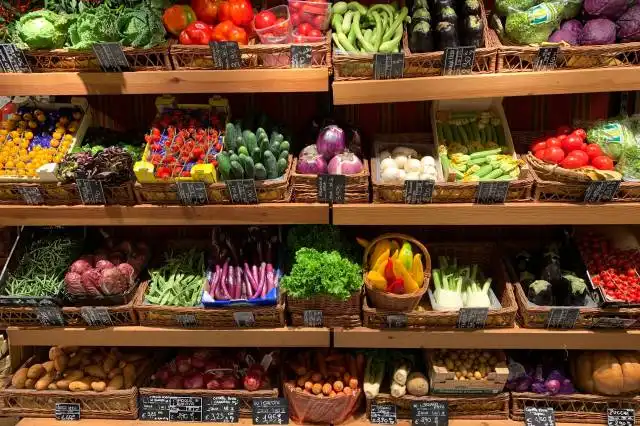Start an Indian Grocery Store
Your Curry to Success: Launching an Indian Grocery Store Business
| Updated


INDIAN GROCERY STORE
Spice up your entrepreneurial life by opening an Indian Grocery Store, a brilliant blend of zing and zest packed in business form. This tantalizing venture sells a flamboyant variety of Indian foods, spices, fresh vegetables, and other unique items sought after in the Indian cuisine. If you've been curry-ous about launching a business that caters to a burgeoning and flavour-savvy customer base, then needless to say, this might just be your 'masala' to success!
Jump to Business Plan
RELATED BUSINESS IDEAS
Browse ALL Retail & Shopping Business Ideas
Discover Your Perfect Domain
Unlock the door to your online success with our hand-picked selection of premium domain names. Whether you're starting a new venture or rebranding an existing one, the right domain can set the tone for your digital presence. Browse through our curated list, each with its unique potential to enhance your brand's visibility and credibility.
INDIAN GROCERY STORE MINI BUSINESS PLAN
This a quick reality check to help you identify the strengths and weaknesses of your business concept before you dive in.
Business Idea: Indian Grocery Store
Expected Percent Margin:
- Gross Margin: Approximately 30-35%
- Net Profit Margin: Around 5-10%
Earnings Expectations:
- Daily Earnings: Roughly $500 - $1,000
- Weekly Earnings: Approximately $3,500 - $7,000
- Monthly Earnings: Around $15,000 - $30,000
- Annual Earnings: An estimated $180,000 - $360,000
Actions to Hit Those Numbers:
Inventory Management:
- Initial Investment: A sufficient inventory investment of about $50,000 - $75,000.
- Supplier Network: Build robust relationships with distributors of Indian food products.
Marketing and Customer Acquisition:
- Social Media: Leverage platforms like Facebook and Instagram, frequently posting to attract and engage customers.
- Local Advertising: Budget about $500 per month for local advertisements and promotions.
Sales and Customer Experience:
- Staffing: Employ 2-3 full-time employees who understand Indian food products and cultural nuances.
- Customer Experience: Ensure your store offers a warm, welcoming, and culturally authentic experience to customers.
Cost Control:
- Rent: Find a location where the rent doesn't exceed 10% of your expected monthly sales.
- Utilities and Maintenance: Budget for approximately $500 - $1,000 per month.
Business Operations:
- Store Hours: Consider keeping your store open 7 days a week to cater to the needs of your target audience.
- Transaction Volume: Aim for at least 25-50 transactions per day with an average sale price of $20 - $40.
These figures are generalized estimates and may vary based on location, market dynamics, and other individual business aspects. Consult with a financial advisor for more personalized advice.
NOT WHAT YOU HAD IN MIND? Here are more ideas



Browse ALL Retail & Shopping Business Ideas
Grab Your Business Website Name
Before you get caught up in the whirlwind of setting up your business, invest in a domain name. It's a small but significant step that lays the foundation for your brand and makes it easier for customers to find and trust you. Just like you wouldn't build a house without securing the land first, don't build a business without securing your domain name.
"Why? Can't that wait?" Here's why it shouldn't
Step 1: Determine if the Business is Right for You
Breakdown of Startup Expenses
Starting an Indian grocery store requires a significant amount of capital. Before committing to this endeavor, it is important to understand the startup costs associated with the business. This includes the cost of leasing a store, purchasing inventory, hiring staff, and any other costs associated with opening the store. Additionally, you should consider the cost of any necessary licenses or permits that may be required to operate the business. It is important to be aware of the costs associated with starting the business so that you can plan accordingly and budget for the necessary expenses.
Breakdown of Ongoing Expenses
After the initial startup costs, there are ongoing expenses associated with running an Indian grocery store. This includes the cost of purchasing inventory, paying staff, and any other costs associated with running the business. Additionally, you should consider the cost of any necessary licenses or permits that may be required to operate the business. It is important to be aware of the costs associated with running the business so that you can plan accordingly and budget for the necessary expenses.
Examples of Ways to Make Money
There are a variety of ways to make money with an Indian grocery store. This includes selling traditional Indian groceries, offering catering services, and providing delivery services. Additionally, you can offer discounts and promotions to attract customers and increase sales. Additionally, you can partner with local businesses to offer discounts and promotions to their customers. Finally, you can offer online ordering and delivery services to reach a wider customer base.
Step 2: Name the Business
When it comes to naming a business, it is important to choose a name that is memorable and reflects the values of the business. It is also important to make sure that the name is not already taken. A good way to start is by brainstorming a list of potential names and then researching them to make sure they are available. Additionally, it is important to consider the domain name and social media handles associated with the name. It is also a good idea to research the competition to make sure the name stands out. Furthermore, it is important to consider the target audience and the message the business name conveys. Finally, it is important to make sure the name is legally protected, so it is a good idea to consult with a lawyer or trademark attorney.
Step 3: Obtain Licenses and Permits
Local Licenses and Permits
Before opening an Indian grocery store, it is important to obtain all the necessary local licenses and permits. Depending on the state and local laws, this could include a business license, a food establishment license, a sales tax permit, and a health permit. Additionally, there may be zoning permits or sign permits that are required. It is important to research the local laws and regulations to ensure that all the necessary licenses and permits are obtained.
Federal Licenses and Permits
In addition to local licenses and permits, there may be federal licenses and permits that are required. This could include a Federal Employer Identification Number (FEIN) and a wholesale food license. Additionally, if the business will be importing food from other countries, there may be additional permits that are required. It is important to research the federal regulations to ensure that all the necessary licenses and permits are obtained.
Step 4: Secure Financing
Securing financing is a crucial step in starting a business. There are several sources of financing that can be tapped into when starting an Indian grocery store. These include traditional bank loans, venture capital, and crowdfunding. Bank loans are the most common form of financing and are typically the least expensive. Venture capital is also an option, but it is usually reserved for businesses that have a proven track record of success. Crowdfunding is a newer form of financing that allows entrepreneurs to raise money from a large number of people.
Tips for Securing Financing
When seeking financing for an Indian grocery store, it is important to have a solid business plan and a good credit score. Additionally, it is important to research the different types of financing available and understand the terms and conditions associated with each. It is also important to be aware of any fees associated with the financing and to make sure that the loan is affordable. Finally, it is important to have a plan for how the money will be used and to be able to explain that plan to potential lenders.
Step 5: Find a Location
When choosing a location for an Indian grocery store, there are several factors to consider. First, the store should be located in an area with a large Indian population, as this will help ensure that there is a steady stream of customers. Additionally, it is important to consider the competition in the area. If there are already several Indian grocery stores in the area, it may be difficult to compete. Finally, the store should be located in an area with good foot traffic and visibility.
Securing a Lease
Once a suitable location has been identified, the next step is to secure a lease. This can be done by negotiating with the landlord or property owner. It is important to be aware of the terms of the lease, including the length of the lease, the rent, and any additional fees. Additionally, it is important to make sure that the store will be able to meet all of the local zoning regulations.
Obtaining Permits and Licenses
Once a lease has been secured, the next step is to obtain the necessary permits and licenses. This will vary depending on the location, but typically includes a business license, a food safety license, and a health permit. Additionally, it is important to make sure that the store meets all local fire codes and regulations.
Setting Up the Store
Once all of the necessary permits and licenses have been obtained, the next step is to set up the store. This includes stocking the shelves with Indian groceries, setting up the checkout area, and making sure that the store is clean and inviting. Additionally, it is important to make sure that the store is properly labeled and that all of the necessary signage is in place.
Step 6: Design the Store
Layout
Before designing the store, it is important to consider the size of the store, the type of products to be sold, and the target market. The layout of the store should be designed to maximize customer flow and to create an inviting atmosphere. Consider the placement of shelves, refrigerators, and other equipment. Use colors and lighting to create a pleasant atmosphere.
Equipment and Supplies
It is important to purchase the right equipment and supplies for the store. This includes refrigerators, shelving, cash registers, and other items. Consider the size of the store and the type of products being sold. Also, make sure to purchase the necessary supplies such as bags, boxes, and labels. Additionally, consider purchasing a point-of-sale system to help with inventory management and customer service.
Step 7: Hire Employees
When hiring employees, it is important to look for individuals who are reliable, have a good work ethic, and are knowledgeable about the products you will be selling. It is also important to look for employees who are friendly and customer service oriented, as they will be interacting with customers on a daily basis. Additionally, it is important to find employees who are willing to learn and grow with the business.
Training Employees
Once you have found the right employees, it is important to provide them with adequate training. This includes teaching them about the products you will be selling, as well as the policies and procedures of the store. It is also important to provide customer service training, so that employees know how to interact with customers in a friendly and professional manner. Additionally, it is important to provide employees with safety training, so that they know how to handle any hazardous materials or situations that may arise.
Paying Employees
When it comes to paying employees, it is important to be fair and consistent. It is important to pay employees at least minimum wage, and to provide them with any additional benefits that may be available. Additionally, it is important to provide employees with incentives for good performance, such as bonuses or raises. It is also important to provide employees with paid time off, so that they can take a break from work when needed.
Establishing Policies
Finally, it is important to establish policies and procedures for employees to follow. This includes things such as dress code, break times, and customer service policies. It is also important to establish policies regarding the use of technology, such as cell phones and computers. Additionally, it is important to establish policies regarding the handling of money and other sensitive materials. Establishing these policies will help ensure that employees are following the rules and regulations of the store.
Step 8: Market the Store
Advertising is an important part of any business, and an Indian grocery store is no exception. There are a variety of ways to market the store, including print, radio, television, and online advertising. Print advertising can include flyers, newspaper ads, and magazine ads. Radio and television advertising can be done through local radio and television stations. Online advertising can include social media, search engine optimization, and pay-per-click campaigns. Additionally, word-of-mouth referrals are a great way to get the word out about the store.
Promotional Strategies
Promotional strategies are also important for getting the word out about the store. Promotional strategies can include offering discounts, coupons, and loyalty programs. Additionally, offering free samples and hosting events can be a great way to promote the store.
Networking
Networking is also important for marketing the store. Networking can include attending local business events, joining local business organizations, and joining online forums related to the industry. Additionally, networking with other local businesses can be beneficial for cross-promotion.
Storefront
The storefront is also important for marketing the store. The storefront should be inviting and attractive to customers. Additionally, the storefront should be well-maintained and have signage that is easy to read. The storefront should also be well-lit and have a good layout that is easy to navigate.
Step 9: Maintain the Store
Maintaining an Indian grocery store requires a lot of hard work and dedication. It's important to stay organized and keep up with the latest trends in the industry. Additionally, it's important to keep the store looking clean and inviting to customers. Here are some tips for maintaining the store:
Keep up with the latest trends in the industry. This could include stocking new products, offering new services, or changing the store's layout. It's important to stay up to date with the latest trends so that customers know that the store is up to date with the latest products and services.
Make sure the store is clean and inviting. This includes keeping the shelves stocked and organized, as well as making sure the store is free of clutter. Additionally, it's important to make sure the store is well lit and has a pleasant atmosphere.
Offer customer service. It's important to make sure customers are happy and satisfied with their experience. This could include offering helpful advice, answering questions, or helping customers find the products they need.
Stay organized. This includes keeping track of inventory, making sure the shelves are stocked, and keeping up with orders. Additionally, it's important to stay organized when it comes to paperwork, such as bills and invoices.
Advertise. It's important to advertise the store in order to attract more customers. This could include using social media, print ads, or even word of mouth. Additionally, it's important to make sure the store is visible in the local community.
EXPLORE MORE CATEGORIES
Browse ALL Business Idea Categories
TAKE THE NEXT STEPS









